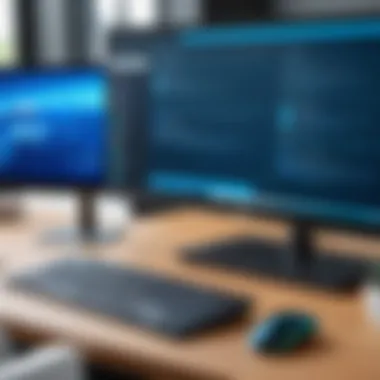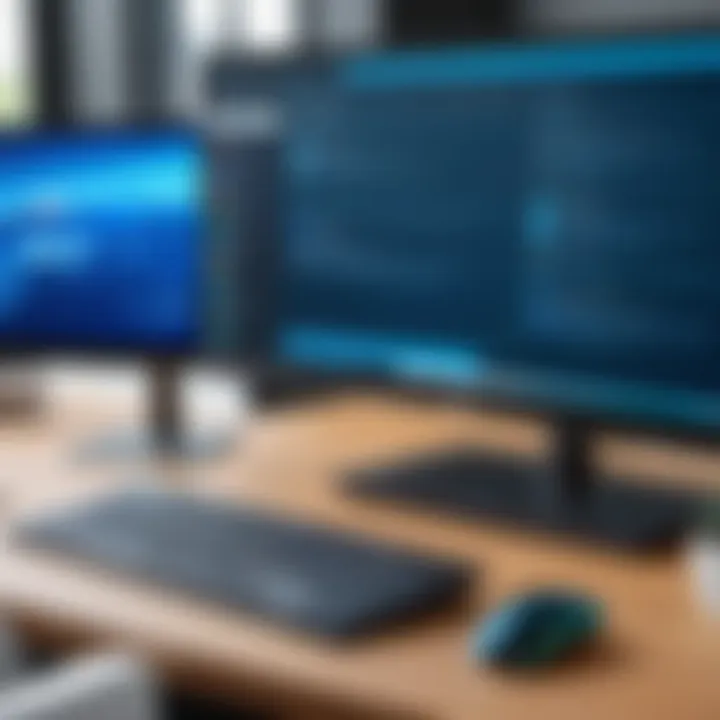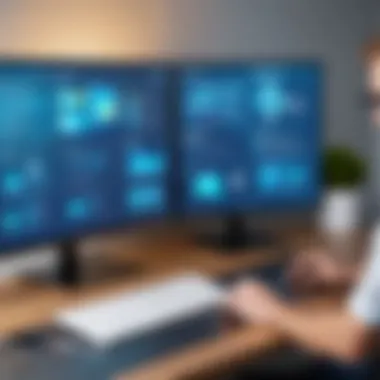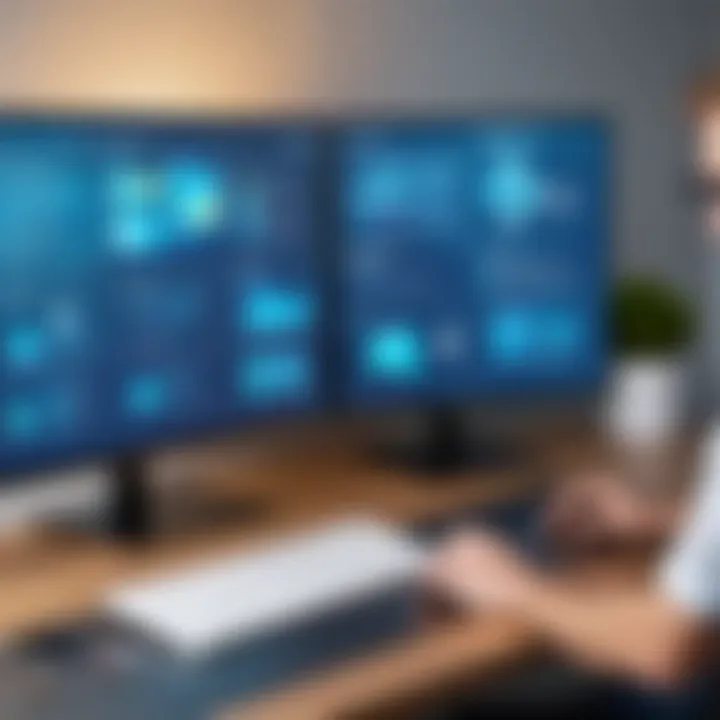Control Windows Remotely: Methods and Tools Explained


Intro
In today’s fast-paced world, the need for remote access to computer systems has become essential. For IT professionals and business owners, managing Windows systems from afar is not just a convenience, but often a necessity. Being able to control a server or workstation remotely streamlines operations, ensures efficiency, and provides a degree of flexibility that is invaluable. This comprehensive guide focuses on the methods and tools available for managing Windows operating systems remotely, addressing critical aspects such as security, functionality, and user best practices.
As we delve into this matter, various tools will be discussed, focusing on their capabilities and how they cater to different user requirements. Whether you operate a small business or are part of a large enterprise, understanding your options can drastically improve your remote management efforts. Comprehending both the advantages and limitations of these tools helps determine the best fit for specific environments.
With cybersecurity threats on the rise, ensuring that remote access is secure must be a top priority. The article will explore the technical requirements and security measures necessary for effective remote control, equipping readers with insights to make informed decisions.
Overview of Software
Remote access software serves as the gateway for controlling Windows systems from any location. These applications not only allow users to operate a computer remotely but also ensure that users can access files, run programs, and manage system settings—as if they were seated right in front of the machine.
Description of Software
Remote access software typically consists of applications designed specifically for connecting and managing devices remotely. Leading software includes TeamViewer, AnyDesk, and Microsoft Remote Desktop. Each solution varies in functionality, usability, and security features, catering to different user scenarios.
Key Features
The essential features to consider when selecting remote access software include:
- Cross-Platform Support: Compatibility with multiple operating systems, including macOS and Linux, expands the usability of the software.
- File Transfer: Allows users to send and receive files easily between local and remote computers.
- Session Recording: Enables recording of sessions for future audits and training.
- Multi-User Access: Facilitates collaboration by allowing multiple users to connect simultaneously.
- Remote Printing: Supports printing documents on a local printer directly from the remote machine.
Software Comparison
Analyzing the capabilities of different remote access solutions can help users choose the most suitable option for their needs.
Comparison with Similar Software
When comparing popular software like TeamViewer, AnyDesk, and Microsoft Remote Desktop, consider the following factors:
- User Interface: Each software has a distinct user interface that contributes to its ease of use. Some applications might be more intuitive, appealing to novices, while others may offer advanced features ideal for experienced users.
- Performance: Factors like connection speed and responsiveness during sessions play a crucial role in user experience. For example, AnyDesk claims to provide low latency due to its proprietary technology.
- Pricing: Many tools follow a subscription model while others offer one-time purchase options. For businesses, understanding the total cost of ownership is vital for budgeting.
Advantages and Disadvantages
Each remote access tool presents unique strengths and weaknesses:
- TeamViewer
- AnyDesk
- Microsoft Remote Desktop
- Advantages: Cross-platform support, robust security features.
- Disadvantages: Higher cost compared to alternatives.
- Advantages: Quick connection setup, low resource consumption.
- Disadvantages: Limited features in the free version.
- Advantages: Built into Windows, no additional cost for Windows users.
- Disadvantages: Primarily designed for Windows, might require complex configurations for other platforms.
Choosing the right remote access software hinges on understanding individual needs and organizational contexts.
This article provides a well-rounded yet detailed perspective, covering not only software descriptions but also considerations for security, practical use cases, and comparative insights. As technology evolves, so too must our approach to managing Windows remotely. With better tools and a clearer understanding, effective remote management is within reach.
Understanding Remote Control of Windows
Remote control of Windows is a vital topic in today’s tech-driven world. As businesses and individuals increasingly rely on digital tools, understanding how to manage Windows remotely becomes essential. Remote control allows users to access and operate a Windows system from another location. This capability is crucial for IT support, remote working, and system maintenance, enhancing flexibility and responsiveness.
Definition of Remote Control
Remote control refers to the ability to operate a computer system from a distant location. In terms of Windows, this often involves using specific software that establishes a connection to a remote device. This software enables users to view and interact with the desktop of the remote Windows operating system as if they were physically present. Functions typically include remote file access, software management, troubleshooting, and system updates.
Historical Context
The concept of remote computing has evolved significantly since its inception. Initially, remote control was largely limited to basic command-line interfaces. Early systems required direct connections over local networks. However, as internet technology advanced, remote access became more feasible and user-friendly. The development of graphical user interfaces allowed more intuitive interactions. By the late 1990s and early 2000s, several companies began marketing software solutions tailored for remote access. These advancements paved the way for broader adoption across various sectors.
Current Trends in Remote Access
Today, remote access solutions have expanded and become crucial for both individuals and organizations. Current trends include:
- Cloud-based services: Many businesses now rely on cloud environments to provide remote access, giving users freedom from local hardware constraints.
- Integration of Artificial Intelligence: Some remote access tools are incorporating AI for automation, such as automatically diagnosing and resolving issues.
- Increased focus on security: With growing cyber threats, companies prioritize secure remote access through encryption and fortified authentication methods.
Understanding these trends is key for IT professionals, as they adapt strategies to improve operational efficiency.
Benefits of Remote Control for Windows
Understanding the benefits of remote control for Windows is crucial for IT professionals and businesses alike. Remote access technologies allow users to manipulate and monitor Windows operating systems from various locations. This flexibility enhances operational capabilities across a multitude of environments, especially as remote work becomes more prevalent. Here, we will discuss the three core benefits: increased efficiency, cost savings, and enhanced collaboration.


Increased Efficiency
Increased efficiency is perhaps the most compelling reason for organizations to adopt remote control solutions. Remote access tools enable users to perform tasks without physically being at their workstation. This means that disruptions due to geography no longer apply.
- Quick response times: IT support can troubleshoot issues swiftly, which reduces the downtime for both employees and systems.
- Flexibility of hours: Employees can work outside of standard business hours without the need to be in the office. This can lead to higher productivity levels, especially for those who manage workloads that span multiple time zones.
- Task management: With remote configuration, system administrators can schedule updates or maintenance at times that minimize impact on daily operations. The ability to execute such tasks remotely provides significant time savings for both employees and IT teams.
Cost Savings
Cost savings is another critical advantage associated with remote control of Windows systems. Businesses can leverage these technologies to reduce various overheads, which can improve net margins. Here are a few considerations:
- Reduced travel costs: Assigning technicians to fix issues onsite can incur high travel expenses. Remote access mitigates this by allowing support teams to assist users from afar, eliminating the need for a physical presence.
- Lower real estate expenses: As businesses increasingly adapt to flexible work environments, maintaining large office spaces becomes less necessary. Remote control solutions facilitate work-from-home arrangements without requiring additional resources, such as dedicated desk space, resulting in savings on office rent and utilities.
- Decreased hardware expenditure: Virtualization can allow companies to prolong the lifespan of existing hardware by reducing the need for constant upgrades, as users can access the same applications and information from multiple devices.
Enhanced Collaboration
The potential for enhanced collaboration using remote control technologies is significant. In a fast-paced business ecosystem, teamwork and communication are essential. Here’s how remote access contributes:
- Shared resources: Teams can access the same files and applications regardless of their location. This enables shared efforts on projects, making it easier to work collectively even in distributed environments.
- Real-time feedback: Employees can communicate instantaneously, allowing for quicker decisions and adjustments. Remote tools often integrate chat features that help teams discuss issues or brainstorm solutions as they encounter problems.
- Cross-functional teams: Organizations can form cross-functional teams without geographical limitations. Talent can connect without the constraints of commutes or relocation, giving organizations access to a wider talent pool.
In summary, remote control for Windows is more than a convenience; it is a strategic move that boosts efficiency, reduces costs, and promotes better collaboration. The advantages it offers can yield considerable benefits for various stakeholders, including IT professionals and business leaders. Exploring these benefits will help guide decisions on adopting remote technologies in an increasingly digital-oriented work environment.
Technical Requirements for Remote Control
Understanding the technical requirements for remote control is crucial for successful implementation. In today's digital landscape, where remote work and virtual support are increasingly common, it is essential to ensure that both hardware and software environments are optimized and ready for remote access solutions. Here, we explore the different aspects that constitute the technical requirements needed for remote Windows control.
Hardware Specifications
Hardware plays a pivotal role in facilitating remote control. The requirements can vary based on the software used, but certain fundamentals apply universally. A computer designated for remote access should possess a decent processor, at least 8 GB of RAM, and sufficient storage capacity. Recommended specifications often include the latest Intel or AMD processors to handle multiple tasks simultaneously without lag. In addition, a dedicated graphics card may enhance performance for graphics-intensive applications.
Keep in mind that the host machine must also support the specific operating system version. For instance, Windows 10 or above is generally recommended for optimal performance with various remote access solutions. Connected peripherals like webcams or microphones can enhance remote collaboration, so ensuring compatibility is also important.
Software Dependencies
Software dependencies encompass the applications or platforms that need to be installed and configured for remote control. Remote access solutions like TeamViewer, AnyDesk, or Microsoft Remote Desktop come with their own requirements that must be met.
For example, TeamViewer requires a compatible version of Windows, as well as specific updates to be installed for smooth operation. On the other hand, AnyDesk supports various operating systems, including Windows, Linux, and macOS, thereby providing flexibility in usage.
Updating existing software is also crucial since outdated applications can pose security risks and reduce functionality. Administrative permissions may be necessary to install or update such applications, which must be considered before setting up remote access.
Network Considerations
Network conditions significantly influence the effectiveness of remote control. A stable and high-speed internet connection is necessary to ensure smooth performance without interruptions. For most remote access software, a minimum speed of 1 Mbps is generally a threshold that should be exceeded for optimal performance.
Several aspects of the network require attention:
- Latency: High latency can lead to delays in command execution.
- Bandwidth: Adequate bandwidth ensures that simultaneous users do not impair performance.
- Firewall Settings: Adjustments might be required to allow remote access applications to operate effectively without conflicts.
- Router Configuration: Certain remote solutions may need specific port forwarding settings to facilitate remote connections.
Popular Remote Access Software for Windows
Popular remote access software is critical for efficiently managing Windows systems from afar. These tools form the backbone of modern remote control solutions, catering to diverse needs across industries. Ranging from cost-effectiveness to security features, the right software can simplify remote management processes, enhance productivity, and improve collaboration.
TeamViewer
TeamViewer is well-known for its robust remote access capabilities. This software allows users to connect to remote devices, making it possible to provide technical support or collaborate in real-time. One of its key features is cross-platform support, enabling connections between Windows, Mac, Linux, iOS, and Android devices. This versatility is beneficial for organizations with varied operating systems.
The user interface is straightforward, which is significant for quick setup and ease of use. TeamViewer also integrates security protocols like end-to-end encryption, protecting data during transfers. It is also useful for attending meetings or conducting training sessions.
TeamViewer’s cross-platform flexibility and strong security measures plays a crucial role in its popularity.
AnyDesk
AnyDesk is notable for its speed and responsiveness. One aspect that sets it apart is its low latency, which is essential for tasks requiring real-time interaction, such as graphic design and gaming. The software operates on a proprietary codec that optimizes performance even with low bandwidth, a common issue for remote connections.
Its seamless file transfer functionality can be crucial when sharing documents or updates instantly. AnyDesk supports multiple operating systems, facilitating easy connections between teams working on different platforms. Security is also a priority, with features including two-factor authentication and TLS 1.2 encryption, which secures the connection against unauthorized access.
Microsoft Remote Desktop
Microsoft Remote Desktop leverages the built-in capabilities of Windows operating systems. For businesses already within the Windows ecosystem, this tool minimizes overhead since it does not require additional software installations. Configuring connections can be done easily through system settings.
Utilizing RDP (Remote Desktop Protocol), it efficiently connects users to their desktops or applications installed on remote servers. Security features include network-level authentication and support for smart card logins, which can be significant for organizations handling sensitive information. However, it can be less flexible in mixed environments compared to other solutions, which is a consideration for firms with diverse computing systems.
LogMeIn


LogMeIn offers an array of features aimed at businesses for remote control, file sharing, and collaboration. This software excels with its user-friendly dashboards and extensive administrative features. For instance, it provides remote printing and mobile access, enabling effective functioning from anywhere.
Security is a prime focus, with features such as multi-factor authentication and a dedicated support team available for immediate assistance. Pricing plans are structured to cater to various business sizes, from freelancers to large enterprises. This flexibility can help organizations scale their remote access needs securely as they grow.
Security Considerations in Remote Control
Security is a paramount concern in the realm of remote control of Windows operating systems. As organizations increasingly rely on remote access for operational efficiency, understanding the associated security risks has never been more critical. This section explores noteworthy security vulnerabilities, best practices for securing remote access, and the vital role of encryption in safeguarding sensitive data. Addressing these aspects ensures that both small and large businesses can maintain a robust defense against potential threats.
Common Security Vulnerabilities
Remote access solutions can expose systems to various security vulnerabilities, some of which include:
- Weak Passwords: Many users neglect to create strong, complex passwords. This opens the door to unauthorized access.
- Unpatched Software: Outdated software can harbor known vulnerabilities susceptible to exploitation. Regular updates are essential.
- Unsecured Networks: Accessing remote systems through insecure networks can lead to data interception by malicious actors.
- Malware Risks: Remote access increases the risk of infecting systems with malware if proper security measures are not in place.
Mitigating these vulnerabilities requires vigilant monitoring and proactive strategies to ensure that remote access remains secure and reliable.
Best Practices for Securing Remote Access
Implementing best practices can greatly enhance security in remote access scenarios. Here are key recommendations:
- Use Multi-Factor Authentication (MFA): MFA provides an additional layer of security, making unauthorized access much harder.
- Regularly Update Software: Keeping software up to date minimizes the risk of exploitation from known vulnerabilities.
- Implement Network Segmentation: Isolating remote access to specific parts of the network can limit exposure and potential breaches.
- Conduct Security Audits: Regular security audits help identify areas of risk and develop strategies for improvement.
- Educate Users: Training employees about security protocols is vital. This can reduce human error, which is often the weakest link in security.
By adopting these measures, organizations can significantly bolster their remote access security posture and protect critical information.
Role of Encryption
Encryption plays a crucial role in securing remote connections. It safeguards data transmitted between the user's device and the remote system, ensuring that sensitive information remains confidential. Here are key points regarding encryption's importance:
- Data Integrity: Encryption helps prevent unauthorized alteration of data during transmission. This ensures that the data received is the same as the data sent.
- Confidentiality: By encrypting data, organizations can protect sensitive information from eavesdropping and potential leaks.
- Regulatory Compliance: Many regulations require data protection measures, and encryption is often a key compliance requirement for organizations.
"Security is not a product, but a process." This maxim underscores the importance of adopting a comprehensive and proactive approach to security in remote control environments.
Setting Up Remote Access on Windows
Setting up remote access on Windows is a critical step in utilizing the extensive capabilities of remote control technology. As businesses gravitate towards flexibility and telecommuting, ensuring proper setups becomes vital. The process not only amplifies productivity but also supports effective collaboration across teams. This section will delve into the various components involved in establishing remote access, emphasizing its significance in contemporary work environments.
Installation Process
The installation process is the first step in achieving remote access on a Windows system. Users often begin by selecting suitable software that meets their requirements. Popular remote access tools such as TeamViewer, AnyDesk, and Microsoft Remote Desktop come equipped with streamlined installation processes.
To initiate installation, follow these steps:
- Download the Software: Access the official website of the chosen software and download the installation file.
- Run the Installer: Locate the downloaded file and run it. This usually requires administrative privileges.
- Accept User Agreement: Review and accept the software’s end user license agreement to proceed.
- Select Installation Options: Sometimes, users can customize the installation. This includes choosing components and installation locations.
- Finish Installation: Complete the installation process by clicking the finish button.
It is vital to ensure that system requirements for the software are met before proceeding, as insufficient hardware or outdated operating systems can lead to complications.
Configuration Steps
Configuration sets the stage for effective remote access. Once installation is complete, configuration must be completed carefully. For most software, this involves:
- Create an Account: Some software requires users to create an account for authentication purposes.
- Set up Security Options: Prioritize security features like two-factor authentication when available. It is critical for safeguarding access.
- Configure Settings: Tailor settings based on specific needs, such as screen resolution and bandwidth usage. Each tool has distinct settings that impact performance.
- Allow Remote Connections: In Windows settings, ensure that remote connections are enabled to allow access from compatible devices.
- Network Setup: Adjust any necessary router settings, which may include port forwarding, to allow smooth communication between devices.
Proper configuration can significantly reduce potential downtimes when accessing systems remotely.
Testing Remote Connection
Testing the remote connection is essential to ensure everything is set up correctly. After configuration, verify that the system can be accessed as intended. A straightforward approach would involve:
- Attempt Connection: Utilize an alternate device to try connecting to the Windows system.
- Monitor Performance: Assess the responsiveness and overall connection quality. Note any latency issues or disconnects.
- Review Logs: Examine connection logs provided by the remote access software. They can reveal errors that may need resolving.
- Adjust Settings: If issues are detected, revisit the configuration settings and make necessary adjustments.
Testing allows users to identify potential roadblocks early, facilitating a smoother experience when true remote access is needed. This step bridges the gap between theory and practical application.
In summary, setting up remote access on a Windows system is essential for effective remote management. Installation is just the start; proper configuration and testing ensure that remote control software functions reliably. Attention to each aspect results in better security and efficiency, pivotal for modern work setups.
Troubleshooting Remote Control Issues
Troubleshooting is a critical aspect of remote control for Windows. Remote access allows users to connect and manage systems from different locations. However, this convenience can come with issues. Knowing how to troubleshoot these issues can save time and resources. Effective troubleshooting enhances user productivity and ensures smooth operation. In this section, we will discuss common issues and errors, diagnostic tools, and when to seek professional help.
Common Issues and Errors
When using remote control software, various issues may arise. Some common problems include:


- Connection Failures: Users often experience difficulties connecting to remote systems. This may arise from network configuration issues or software settings.
- Slow Performance: Sometimes, the remote session can become sluggish. This slowdown can be due to bandwidth limitations or insufficient system resources on either end.
- Authentication Errors: Wrong credentials lead to failed logins. Users must ensure they enter correct usernames and passwords.
- Screen Resolution Problems: Display issues are common. Depending on different display settings, the remote screen may not render correctly.
Awareness of these issues can help users quickly diagnose problems and apply necessary solutions.
Diagnostic Tools
To effectively troubleshoot, utilizing specific diagnostic tools can be beneficial. These tools offer insights into the performance and configuration of remote connections. Some recommended tools are:
- Ping: This command-line tool helps check the connection to the remote machine. Using Ping can determine if the device is reachable.
- Traceroute: This tool traces the path network packets take to reach the remote system. It helps identify routing issues.
- Network Monitoring Software: Programs like Wireshark allow users to inspect data travel across the network. This analysis can reveal potential bottlenecks or interruptions.
These diagnostic tools provide valuable data that can direct troubleshooting efforts.
When to Seek Professional Help
Although many issues can be resolved independently, some situations require expert intervention. Here are signs that it may be necessary to seek professional help:
- Persistent Connectivity Issues: If users constantly face connection failures despite troubleshooting attempts, professionals should evaluate the network.
- Complex Configuration Problems: Configuring advanced settings can be tricky. When settings are not easily understood, expert guidance can help.
- Security Breaches: If there are signs of unauthorized access or security issues, it is vital to contact security professionals immediately.
- Lack of Internal Resources: Sometimes, organizations do not have the in-house expertise necessary for troubleshooting specific remote access software.
In these scenarios, timely professional assistance can prevent further complications and protect sensitive data.
Troubleshooting remote control issues is vital for maintaining efficiency and security in remote management.
By understanding these elements, users can navigate the troubleshooting process more effectively. Quick identification of issues, correct usage of diagnostic tools, and determining when to consult experts contribute to better remote access management.
Use Cases for Remote Windows Control
Remote control of Windows systems has vast potential in modern digital environments. Effective application of remote access enhances productivity, increases operational efficiency, and aligns with current workspace trends. Understanding use cases is crucial for IT professionals, software specialists, and businesses of all sizes. Here, we explore several key applications of remote control for Windows, shedding light on their significance.
Remote Technical Support
Remote technical support stands as one of the most prominent use cases. This approach allows technicians to access user systems directly, solving issues without needing to be physically present. It reduces downtime significantly, a crucial factor in any business operation. For example, if a user faces software malfunction, support teams can diagnose and fix problems in real-time, enhancing customer satisfaction.
Tools like TeamViewer or Microsoft Remote Desktop enable support staff to view the user's screen and take control if necessary. This immediacy not only accelerates problem resolution but helps in conducting comprehensive training sessions and demos directly on the user’s system. The ability to provide assistance without geographical barriers protects productivity and streamlines communication between users and support staff.
Flexible Work Arrangements
Flexible work arrangements have gained traction, particularly in light of recent global events. Employees now frequently work from various locations. Remote control software ensures they can access necessary applications and files in a secure manner. This flexibility supports work-life balance while maintaining productivity.
Remote access enables employees to connect to their corporate systems as if they were in the office. They can collaborate with their teams seamlessly, regardless of distance. Organizations can utilize tools like AnyDesk or LogMeIn to facilitate smooth remote work environments. Security and data protection features, such as encryption, become vital in this scenario. Hence, fostering a secure remote work culture is imperative.
System Administration
System administration is another critical area of remote Windows control. Administrators can manage multiple systems across various locations efficiently. They can perform routine maintenance, updates, and configurations without being onsite. This capability allows quicker responses to system alerts and reduces maintenance costs.
Using software like Microsoft Remote Desktop, system administrators can efficiently monitor system performance, spot issues, and execute preventative measures. Additionally, the remote administration can help in deploying software updates or patches across a network swiftly. It plays a fundamental role in maintaining system integrity and security.
In summary, each use case for remote control of Windows emphasizes efficiency, security, and adaptability in today’s digital landscape. The ability to provide remote technical support, facilitate flexible work arrangements, and enable effective system administration showcases the comprehensive advantages remote control technologies offer.
Future Trends in Remote Control Technology
The landscape of remote control technology for Windows is evolving rapidly. Various factors drive this change, such as increased demand for remote work solutions, heightened security concerns, and advancements in technology. Understanding these trends is vital for IT professionals, businesses, and software developers. Each trend will influence how remote control applications are developed, secured, and integrated into existing systems. Organizations that keep abreast of these advancements can stay competitive and ensure a secure, efficient, and effective remote control setup.
Emerging Technologies
Emerging technologies are reshaping remote control for Windows. Virtual reality (VR) and augmented reality (AR) are now being integrated into remote access solutions. These technologies enhance user experience, enabling remote users to interact with systems more intuitively. Additionally, the rise of 5G networks significantly enhances the speed and reliability of remote connections. Low latency and high bandwidth from 5G can improve the fluidity of remote sessions, making tasks seamless.
Futhermore, cloud computing is revolutionizing how remote access tools are deployed. Instead of traditional installations, software is increasingly provided as a service (SaaS). This shift allows for easier updates, better scalability, and reduced IT overhead for businesses.
- Key technologies on the rise include:
- VR and AR Integration
- 5G Capabilities
- Cloud-Based Solutions
Impact of Artificial Intelligence
Artificial intelligence (AI) is set to transform remote control technologies. AI can automate tasks, provide predictive troubleshooting, and enhance security measures. Through machine learning, remote access applications can learn user behaviors, allowing for a more personalized experience and better performance. Additionally, AI can enhance security by identifying unusual activities, which is essential in environments where sensitive data is handled.
AI chatbots are also becoming common in remote support scenarios, providing instant assistance without the need for human intervention. These developments improve efficiency and user experience, leading to higher satisfaction for remote setup.
"AI has the potential to greatly streamline the remote access experience, making it more secure and efficient."
Integration with IoT Devices
The integration of Internet of Things (IoT) devices into remote control technology introduces a new layer of complexity and opportunity. As more devices connect to networks, the need for effective remote access solutions grows. This integration enables remote monitoring and managing of devices such as smart printers, cameras, and thermostats.
Companies can harness IoT data to optimize operations, allowing for real-time analytics and decision-making. However, integrating these technologies requires a robust security framework to handle the increased risk of potential breaches that come with more connected devices.
In summary, the future of remote control technology for Windows is filled with potential. Emerging technologies, AI, and IoT integrations will help organizations redefine how they manage remote access. Being aware of these trends ensures that businesses can adapt and implement strategies effectively.















